Introduction
“I’m leaving Luang Prabang for Vientiane; are you joining me?” Barely received the message that I booked a plane to Vientiane, impatient that I was to leave the incessant hubbub of Hanoi. My friend knew it: I was dying to discover Laos, he had just offered me a unique opportunity to realize my dream! Here is my travel diary in Vientiane, capital of Laos…
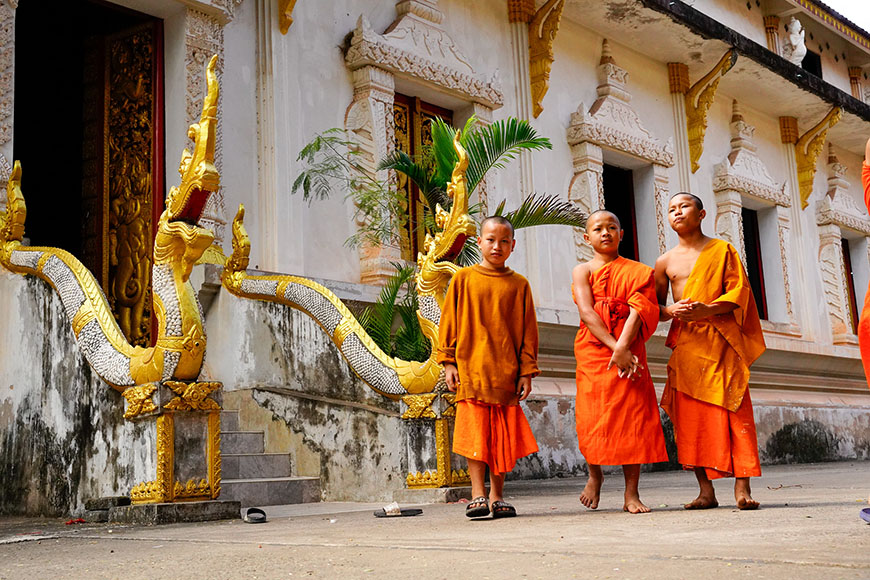
Young monks in front of a temple, Vientiane - Photo : Mr Linh's adventures
Once upon a time…
It takes just over an hour to fly to Vientiane from Hanoi. The time just needed to fly over (no pun intended) the history of the capital of the Kingdom of the Million Elephants.
The long and rich history of Vientiane dates back to the 1st century BC. In the early centuries of our era, the Chams, originally from a Hindu kingdom in central Vietnam, occupied the south of the country. Moreover, it is they who will give their name to Champasak (the Chams of Bassak). Around 900, the Khmers crushed them, their territory extending two centuries later to the Vientiane region.
The Cham and Khmer were influenced by Indian culture and were therefore opened to the spread of Buddhism in the Indochinese peninsula from the 7th century. From the 1st century, the Tai tribes, displaced by the Mongols, infiltrated the region and gradually converted to Buddhism. They will occupy Laos and the southeast region of Thailand.
The Kingdom of the Million Elephants
In the 14th century, King Fa Ngum established the kingdom of Lane Xang Om Khao, which will be the first Lao kingdom, the Kingdom of the Million Elephants. Descended from the legendary King Khun Bourom, Fa Ngum was a unifier and, at its peak, the kingdom extended to northern Thailand and northwestern Vietnam. But in 1373 he was replaced by his son Unhean.
During the 16th century, King Setthathirat moved the capital of the kingdom of Luang Prabang to Vientiane to distance himself from the Burmese threat.
We are now in the 17th century, which sees King Souligna Vongsa restore the unity of the country and the kingdom prosper again. In those years, the first Western accounts speak of the golden age of the Lao kingdom, while monks from Cambodia and Siam come to study at That Luang and receive their diplomas.
Conflicts and forfeiture
In the early 18th century, following the death of King Souligna Vongsa who had no heir, conflicts arose over succession. This led to the division of the kingdom into three distinct entities: the kingdom of Luang Prabang in the north, the kingdom of Vientiane in the center and the kingdom of Champasak in the south. At the end of the 18th century, the Siamese took control of the kingdoms of Luang Prabang and Champasak, as well as the Ph'ra Keo, the Emerald Buddha, which is now in Bangkok. And then, in 1826, King Anouvong, who had been placed on the throne by the Siamese and allied with them in their wars against the Burmese, rebelled. His army was defeated twice when he entered Siam, and in 1827, Vientiane, the capital of the kingdom, was looted and its inhabitants deported to the other side of the Mekong. Only the Wat Sisakhet, which Anouvong had built, remained unscathed, and the last king of Vientiane died prisoner in an iron cage in Bangkok in 1835.
The French in Laos
In 1800, the French took control of Vietnam, Cambodia and Laos and gathered them in French Indochina. In 1861, Henri Mouhot left for Luang Prabang as an explorer, while in 1867, Doudart de Lagrée crossed the Mekong to reach the former capital of the kingdom of one million elephants. At the end of the 19th century, French warships blocked Bangkok, preventing Siamese claims. Auguste Pavie, appointed vice-consul of France in Laos, arrives in Luang Prabang while the Black Pavilions take control of the city. The band of Chinese looters retreats before the troops of King Oun Kham.
Auguste Pavie’s diplomacy will have a significant impact on the creation of the French protectorate in Laos and its recognition by Siam in 1893. In 1904, Siam transferred the land located on the right bank of the Mekong (which is now the province of Sayabouly) to the kingdom of Luang Prabang. The Lao aristocracy will be willing to accept the French presence; has it not managed to prevent the annexation of Siam? Moreover, the French do not dispute the presence of the king in his palace in Luang Prabang. However, the colonial authorities will face some rebellions.
Vientiane experienced a period of renovation during the French protectorate period, with the construction of colonial-style houses and administrative buildings. However, the French have maintained only a low priority on this issue in Indochina, as evidenced by the modest construction program and the appointment of many… vietnamese directors.
In March 1945, a violent coup was committed by the Japanese to take control of Indochina. Many French officers and soldiers were executed or deported. But in Laos, the local population remained loyal to its king, Sisavang Vong, and helped the French fight against Japanese forces. But inexorably, the Lao kingdom, which was once grandiose, continued to decompose, be fragmented and looted throughout the 19th century and, in particular, in the decades following the departure of the French. The Laotian kingdoms, weakened compared to their Siamese or Vietnamese neighbors, themselves in permanent conflict, become the target of all covetousness.
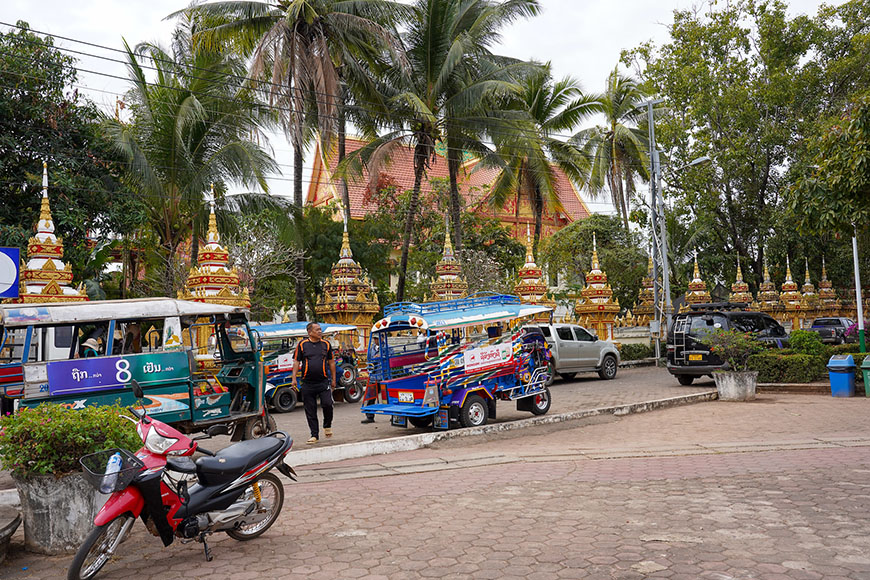
Tuk-Tuk, the best way to move in Vientiane - Photo : Mr Linh's adventures
Modern Laos
In 1964, the United States entered what they called the Vietnam War. They seek to cut the Ho Chi Minh Trail, the network of roads and trails of the Annamitic Cordillera, to counter the communist maquis that receive massive assistance from North Vietnam. Between 1964 and 1974, the «secret war» and the Rolling Thunder operation took place between 1964 and 1969.
While not officially at war, Laos is hit every 8 minutes by a heavy bomber. By comparing the number of bombs received with the number of inhabitants, Laos sets the sad record of the most bombed country in history. During World War II, the Americans dropped more than 3 million tons of bombs on Laos, more than Germany and Japan combined. The massive bombings were accompanied by a herbicide drop with dramatic consequences. By massively supporting the royal government, the Americans obtained the creation of CIA bases that recruited mercenaries among the mountain minorities, including the Hmong.
While I was reading these few lines, I did not know that I would dive into the horror of this Secret War, by visiting the COPE center.
The Paris Agreements in February 1973 provided for a precarious ceasefire in South Vietnam, while the Vientiane Agreements decided a ceasefire in Laos, the withdrawal of all foreign troops, the dissolution of the "special forces" and the constitution of a government of national unity from 1974. The people who aspire to reconciliation welcome the agreement. The conflict killed about 350,000 people, or one-tenth of the population, and resulted in as many refugees.
Communist Laos
In 1975, under the leadership of Kaysone Phomvihane, who had been the leader of the Lao People’s Revolutionary Party since the 1950s, the communists took power. They reject all other tendencies. Laos becomes Lao PDR after the end of the monarchy.
A Marxist communism is rigidly applied to politics and economics. After seeing its failure, the party congress introduced "the new economic mechanism" in 1986, with the support and pressure of the IMF and the World Bank, with whom they signed assistance agreements in 1989.
The end of communism in the USSR completely eliminated the need to belong to the communist bloc, however Laos will remain a one-party regime whose leaders experienced what they call «the 30-year war, from 1945 to 1975».
To conclude this overview of the history of Laos, it must be said that in recent years have seen an upsurge in construction, road improvement and traffic, largely funded by China. It is likely that this country will continue to have a significant influence on the future of Vientiane and the country as a whole.
Vientiane, or peaceful nonchalance
Of course, I had heard about it, I had read it— But that day, I could see for myself how Vientiane is a kind of big village, bathed in a relaxed and peaceful sub-prefecture atmosphere. Add to that an eclectic mix of colonial settlements, sparkling ancient temples, traditional Chinese and Laotian houses and you will have an idea of the decor of this enchanting languid city on the left bank of the Mekong. Having to join my friend for business reasons, I only had time to marvel at the most emblematic sites of the city founded by a naga. Yes, I almost forgot to tell you about it… Did you know that Vientiane was born under the impulse of the legendary and mythical snake with several heads? He lived in the waters of the majestic Mekong River and it happened that he helped a king defeat his enemies. As a reward, the king offered him his daughter in marriage. The naga and the princess had a son who founded the city of Vientiane, whose name means "city of sandalwood".
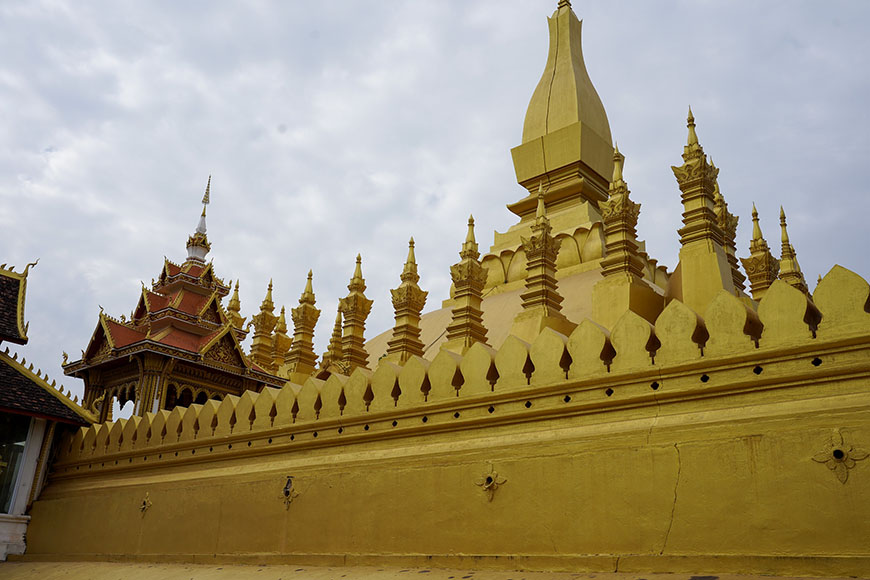
Somptuous That Luang, Vientiane - Photo : Mr Linh's adventures
Once upon a time, in the heart of Vientiane, three magical places that capture the hearts of all who visit them…
The That Luang
The first is the temple of That Luang, which, with its golden stupa rising to the heavens, dominates the city. A sense of calm and serenity invades us when we enter it and transports us into a world of peace and tranquility.
It is the most sacred monument of the whole country - it is supposed to contain a hair of Buddha - whose name means «stûpa supreme».. In 1566, King Setthathirath transferred Vientiane as the capital of the kingdom of Lan Xang, which led to the construction of the That Luang. But it is also said that once, an influential monarch repeated the same dream of an old man who asked him to build a stupa to house a relic of Buddha. Many nights, the king ignored this dream until he accepted the injunction of the mysterious old man of his dream. Thus, he gave the order to build the That Luang, which became an important site for pilgrims and a symbol of the prosperity of Laos. I let you choose the option that makes you dream most… More prosaically, this building is a national pride, to the point of appearing on the coat of arms of Laos and its banknotes.
Good to know:
Centrally located, That Luang is open from 8 a.m. to 6 p.m. It costs 200,000 kips to visit.
- • That Luang is a sacred place, so please dress modestly.
- • Do not touch the stupa.
- • You can take pictures of the That Luang, but it is forbidden to photograph the monks.
- • The best time to visit That Luang is early in the morning or late in the evening, when there are fewer people (you can easily get there by tuk-tuk).
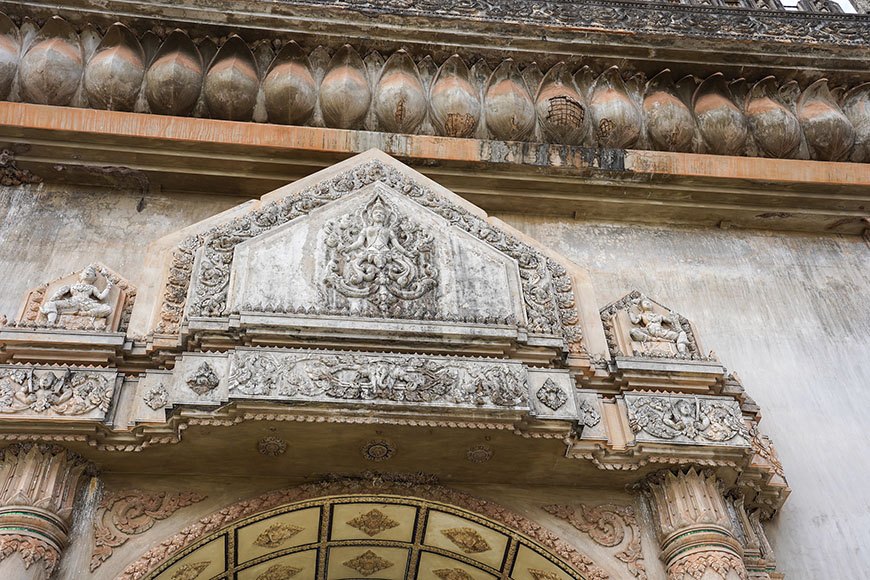
Patuxay (detail), Vientiane - Photo : Mr Linh's adventures
The Patuxay
The second of the magical places is the Patuxay, also known as the "Tomb of the Braves". Literally meaning «Gate of Victory», it is an imposing but elegant memorial to the soldiers who died for Laos during the Indochina War. Its architecture is reminiscent of a certain Parisian Arc de Triomphe…
I started climbing the 197 steps (yes, I counted them!) that lead to the terrace of the central tower. The 360-degree view of the city serves as a reward for this effort shared by many tourists, who also came to admire the perspective of Lan Xang Avenue which leads to the presidential palace and the Mekong River.
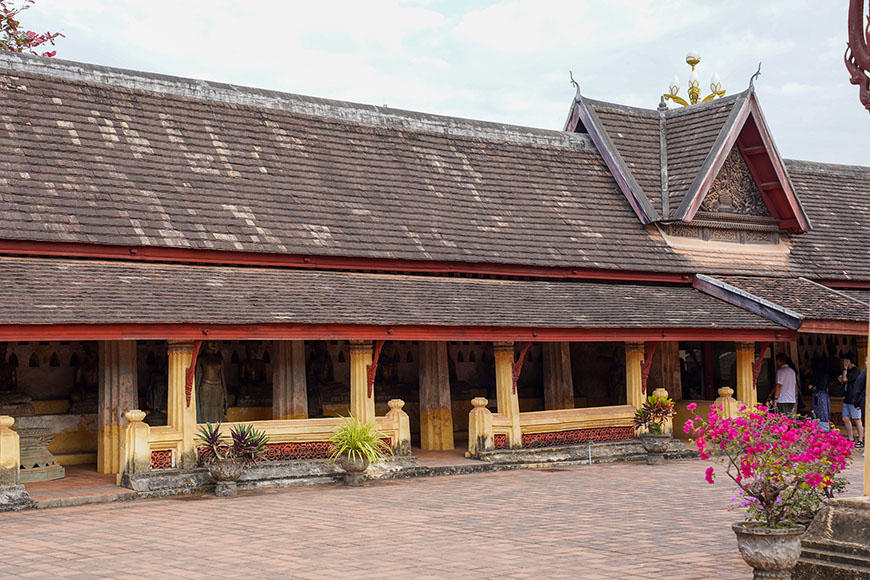
Wat Sisaket, Vientiane - Photo : Mr Linh's adventures
Wat Sisaket (and others)
Finally, the third magical site of Vientiane is Wat Sisaket, the oldest temple in the city.
Known for its many sculptures and mural paintings, this temple surrounded by mystery and legend, would have been built by a conquering king of a Khmer king. Its unique architecture, with many cells filled with small statues of Buddha (it would have counted 2,000), also houses a collection of Lao tales and legends.
I also went to Vat Simuang, which is revered by the locals as it houses the founding square pillar of the city. According to legend, Wat Simuang was built on the site of an ancient Hindu sanctuary in the 16th century by King Setthathirath. It is reported that the king ordered the construction of the temple in order to appease the spirits that haunted the area. It is also reported that a young woman named Si Muang sacrificed herself by throwing herself into the foundations of the temple, thinking that this would calm the spirits and guarantee the prosperity of the temple. Anyway, the grave of the father of one of my friends is just behind, after the steles. What makes this place so special to me…
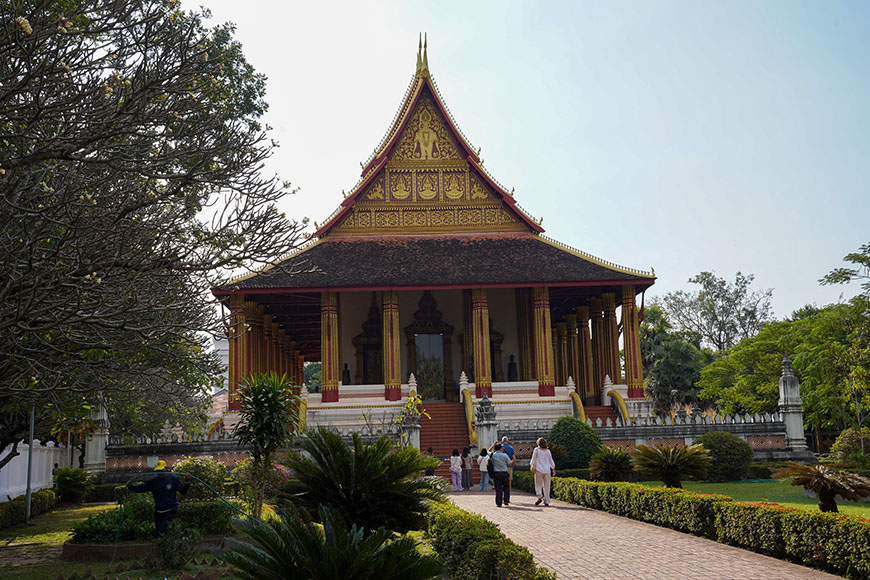
Wat Phra Keo, Vientiane - Photo : Mr Linh's adventures
Finally, I would like to talk about Wat Phra Keo. Once upon a time, this respected temple hosted the sacred relic of the Emerald Buddha – in fact, green jade. A Lao king would have brought this statue to Vientiane after finding it in a Khmer temple. The Emerald Buddha is considered a symbol of divine prosperity and protection for Laos. However... The emerald Buddha is no longer in Vientiane. It was carried to Bangkok in 1779 by the Siamese after their victory over Laos. Currently, it is located at Wat Phra Kaew, within the Grand Palace of Bangkok, Thailand. But Wat Phra Keo is still an important place to visit, with fascinating representations of Boudddha and other religious art objects, allowing a unique insight into the history and culture of Laos.
These three magical places have literally captured my heart, and I know now that I will never forget the enchanting city of Vientiane.
Good to know:
Wat Sisaket is located on Lane Xang Street and is open from 8:30 a.m. to 12:00 p.m. and from 1:00 p.m. to 4:00 p.m. Remember to wear a correct and respectful outfit (shoulders and knees covered)
You will find Wat Phra Keo in Thanon Luang Street. You can visit between 8am and 12pm and from 1pm to 4pm. The ticket is 30,000 kips and of course, the dress code is the one indicated for the visit of the sacred places (shoulders and knees covered).

The COPE Center, Vientiane - Photo : Mr Linh's adventures
The COPE visitor centre
Founded in 1997, the local cooperative COPE manufactures and distributes devices and prostheses for victims of UXO (unexploded ordnance during the CIA’s secret war during the Vietnam War). It also aims to raise public awareness of the tragedy of these munitions.
The Cooperative Orthotic and Prosthetic Enterprise is located on Khouvieng Road. The Centre is open daily from 8:30 a.m. to 4:00 p.m.
Some practical information about Vientiane
The best season to enjoy the charms of the capital of Laos
My (too short) stay in Vientiane took place during the dry season (between November and April), it is this period that I recommend, for its blue sky and pleasant temperatures (chilly like me will appreciate…). From May to October, it is the wet season, with its tropical rains and its shiny and green nature. At this time, it is the prices that are pleasant, which seems perfect for greenhouse budgets.
Where to stay in Vientiane
There is no shortage of hotels to choose from… Three points of reference for choosing your next cosy nest:
- • Downtown: Best if you want to stay in tourist hotels or fancy hotels and enjoy the lively bars
- • Sisattanak will be your choice if you are looking for an authentic local atmosphere, budget guesthouses and family-friendly restaurants
- • The banks of the Mekong are perfect for enjoying a peaceful and rather luxurious setting with a magical view of the river
.jpg)
Delicious Lao food ! Photo : Mr Linh's adventures
Laotian cuisine
You can refer to the article already mentioned at the very beginning of this travel diary in Vientiane. I will add here my own preferences:
- • Khao piak sen, the all-day, all-day national dish with chicken rice noodle soup.
- • Tam mak houng, the classic spicy and refreshing green papaya salad (best enjoyed at Morning Market)
- • Xiang Khouang, the ultimate gourmet break: imagine crispy pancakes filled with vegetables and meat…
- Getting around in Vientiane
- • Tuk-tuk: the convenient and economical option to explore the city.
- • Bike: ideal to walk at your own pace and discover the hidden charms of Vientiane.
- • Taxi: comfortable solution for long trips or night trips.
- • Walking: Downtown is compact and easy to explore on foot.
Closing Remarks
Vientiane is a city where you take the time to live and reserve authentic and intense experiences. Between temples, gastronomy and meetings, in a peaceful atmosphere, Vientiane seduces gently all travelers…